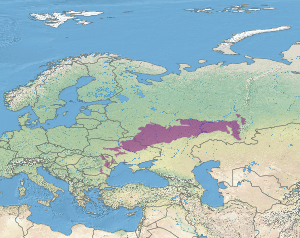East European forest steppe
| Ecoregion: East European forest steppe | |
|---|---|
.jpg) Central Black Earth Nature Reserve, an example of forest steppe terrain, in Kursk Oblast, Russia | |
 Ecoregion territory (in purple) | |
| Ecology | |
| Realm | Palearctic |
| Biome | Temperate Broadleaf and Mixed Forests |
| Geography | |
| Area | 727,269 km2 (280,800 sq mi) |
| Countries | Russia |
The East European forest steppe ecoregion (WWF ID:PA0419) is a patchwork of broadleaf forest stands and grasslands (steppe) that stretches 2,100 km across eastern Europe from the middle of Ukraine to the Ural Mountains in Russia. There are also isolated areas of similar character off the western end in eastern Romania, Moldova, and Bulgaria. The region forms a transition zone between the temperate forests to the north, and the steppe to the south. The forest-steppe is an area of Russia in which precipitation and evaporation are approximately equal.[1] The ecoregion is in the Palearctic ecozone, with a Humid Continental climate. It covers 727,269 km2 (280,800 sq mi).[2]
Location and description
The ecoregion forms a long band, about 2,100 km long and 600 km wide, from Ukraine in the west to western edge of Siberia at the Ural Mountains in the east. Most of the terrain is rolling hills and some plains. Average elevations range from 150 meters (above sea level) in the lowlands to 250 meters in the hills, with some isolated ranges of low mountains on the edges of the area.[1][2][3]The ecoregion can be divided into sub-provinces from west to east: Dnieper Upland, Dnieper Lowland, Central Russian Upland, Oka-Don Plain, Volga Upland, and the Trans-Volga. Moisture diminishes as the ecoregion stretches to the east, as does the forest fragmentation.[4]
Climate
The region has a Humid continental, cool summer climate (Koppen classification (Dfb)). This climate is characterized by high variation in temperature, both daily and seasonally; with dry winters and cool summers. The "cool summer" designation indicates that at least no month averages above 22 °C (72 °F). The summers become hotter and the winters colder as you move east across the ecoregion, due to the movement towards the center of the continent ("continentality").
Flora and fauna
For centuries, scientists have speculated on the causes of variations in stands of trees. It is currently understood that on the macro level, steppes are more arid and that trees thin out in the transition zones. Because the terrain of the ecoregion is relatively flat or low hills, with no physical barriers between the biomes to the north and south, the plant communities tend to be shaped by local variations in water flow. Differences in drainage, variations in soil type (pine trees on sandy soil, deciduous trees on loamy soil, etc.) and salinity, the effects of blowing wind (which drives snow off the hills into depressions, affecting soil quality), and the historic activities of humans all combine to create the mosaic character of the region.[1]
Open landscapes show that steppe plant communities can compete with forest. Sedges are characteristic in the steppe areas, resisting low-moisture conditions with much of their biomass underground.[5]
Protections
The East European forest steppe has been affected heavily by human pressure: over half is arable land, and the natural forest stands have mostly been cleared. Little of the territory is legally protected as nature reserves, and such reserves that exist tend to be small tracts set aside for study. Representative protected areas in the ecoregion include:
- Bashkiriya National Park, on the eastern tip of the ecoregion, at the southern base of the Ural Mountains. (Area: 920 km2)
- Belogorye Nature Reserve, one of the last riverine old-growth oak forests that used to be typical of the East European Forest-Steppe. (Area: 21 km2)
- Chavash Varmane Bor National Park, a large unbroken forest in the middle Volga region of Chuvashia. (Area: 252 km2)
- Galichya Gora, six small clusters of botanical habitats of the Central Russian Uplands. (Area: 0.23 km2)
- Kaluzhskiye Zaseki Nature Reserve, an old-growth forest in Kaluga Oblast that has been protected in some form for a thousand years. (Area: 185 km2)
- Khopyor Nature Reserve, protecting floodplains, upland oak forests, and meadows in the Voronezh Oblast region of Russia. (Area: 162 km2)
- Central Black Earth Nature Reserve, a scattered-site reserve of black-soil prairie set aside for scientific study . (Area: 52 km2)
- Voronina Nature Reserve, representative of the riverine wetlands of the Oka-Don Plain. (Area: 108 km2)
- Zhiguli Nature Reserve, mountain ridge surrounded by a bend of the Volga River. (Area: 232 km2)
See also
References
- 1 2 3 "Biomes and Regions of Northern Eurasia - Steppe and Forest Steppe". Russian Nature. Retrieved August 13, 2018.
- 1 2 "East European forest steppe". Ecoregions of the World. GlobalSpecies.org. Retrieved July 23, 2018.
- ↑ "PA0419: Eastern Europe: Bulgaria, Moldova, Romania, Russia, and Ukraine". World Wildlife Federation. Retrieved July 23, 2018.
- ↑ "Biomes and Regions of Northern Eurasia - Classifications: Zonal and Provincial Differences". Russian Nature. Retrieved August 13, 2018.
- ↑ "Biomes and Regions of Northern Eurasia - Biological Diversity". Russian Nature. Retrieved August 13, 2018.